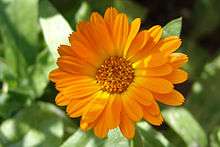Calenduleae
| Calenduleae | |
|---|---|
 | |
| Calenduleae sp. | |
| Scientific classification | |
| Kingdom: | Plantae |
| (unranked): | Angiosperms |
| (unranked): | Eudicots |
| (unranked): | Asterids |
| Order: | Asterales |
| Family: | Asteraceae |
| Subfamily: | Asteroideae |
| Tribe: | Calenduleae Cassini |
| Genera[1] | |
Calenduleae is a flowering plant tribe of the family Asteraceae. Calenduleae has been widely recognized since Alexandre de Cassini in the early 19th century.[2] There are eight genera and over 110 species, mostly found in South Africa.[3]
It is a relatively stable clade of the Asteraceae, with minor alterations. The tribe also occurs in Southwest Asia, some Atlantic islands, other portions of Africa and Europe, with non-native occurrences in the US, Australia, and New Zealand. However, three new species within the tribe have been discovered as recently as 2003.[4][5]
Description
Plants in Calenduleae vary from herbs to shrubs and usually exhibit showy flower heads. The defining characteristics separating members of this tribe from others within the family are a dimorphism of the cypselae and the fact that each cypselae lacks a pappus.[2] Calenduleae is named for its most economically important genus, Calendula, known in homeopathic remedies and as a common ornamental. Other genera from Calenduleae produce ornamentals as well, including Osteospermum and Dimorphotheca (see Asteraceae for a more general description).
History and phylogeny
Cladistic arrangement of this group of plants has been recognized as far back as Andrea Cesalpino in the 1630s and again by Giulio Pontedera in the 1720s, but the official nomenclature arose after Cassini's work within the family. Early 20th-century botanists placed this tribe as sister to the Senecioneae; however, there has been molecular evidence of closer relationships between the Astereae and the Calenduleae.[6] This tribe has demonstrated monophyly through chemical analysis of the similar pimerane diterpenes found within all tested species. Osteospermum and Garuleum share the highest number of identical chemical signatures, indicating close phylogenetic relationship and a more recent divergence than other genera of the tribe.[7] One of the newly discovered Osteospermum has provided evidence of a link between Osteospermum and Chrysanthemoides.
There have been some rearrangements of the Calenduleae tribe. Eriachaenium was originally lumped with the Calenduleae but has since been removed. Its placement remains uncertain, although it is now hypothesized to belong to the Cichorioideae. The genus Castalis has been folded into Osteospermum. One recent analysis of the Calenduleae made several phylogenetic discoveries, including:
- the Osteospermum section Blaxium is now placed in the genus Dimorphotheca
- the subgenus Tripteris was separated from Osteospermum
- the genus Oligocarpus was separated from Osteospermum
- Osteospermum sanctae-helenae, endemic to St. Helena, now belongs to Oligocarpus.[8]
Image gallery
-

Osteospermum "Pink Whirls", a cultivar
-
Dimorphotheca ecklonis syn. Osteospermum ecklonis
References
- ↑ Calenduleae in: Kadereit J.W. & Jeffrey C.,The Families and Genera of Vascular Plants, Volume VIII. Asterales, Berlin, Heidelberg, Springer-Verlag, 2007
- ↑ Small, J., M.Sc. (Lond.), Ph. C (1917) The Origin and the Development of the Compositae New Phytologist 16 (7): 157-177
- ↑ Judd, Campbell, Kellogg, Stevens, Donoghue, ‘Plants Systematics: a Phylogenetic Approach’, Third Edition, Sinauer Associates, Sunderland, MA 2008
- ↑ Nordenstam, B. (2003) Two New Species of Osteospermum (Compositae-Calenduleae)from Southwestern Cape Province, South Africa, Edinburgh Journal of Botany 60:259-265.
- ↑ Woods, A. R, Nordenstam, B (2003) An Interesting New Species of Osteospermum (Asteraceae-Calenduleae) from the Western Cape Province, South Africa, providing a Link to the Genus Chrysanthemoides 69(4):572-578.
- ↑ Mishler, B. D, Albert, V.A, Chase, M. W, Karis, P. O., Bremer, K. R. (1996) Character-State Weighting for DNA Restriction-Site Data: Asymmetry, Ancestors and the Asteraceae, Cladistics 12 (1): 11-19
- ↑ Alvarenga, S. A. V., Ferreira, M. J. P., Rodrigues, G. V. and Emerenciano, V. P. (2005) A general survey and some taxonomic implications of diterpenes in the Asteraceae, Botanical Journal of the Linnean Society 147:291-303.
- ↑ Nordenstam, B. and Trift, I. (1999) A phylogenetic Study of the Calenduleae (Asteraceae), XVI International Botanical Congress Session 3.9.6: 3885
External links
![]() Data related to Calenduleae at Wikispecies
Data related to Calenduleae at Wikispecies
- Nordenstam, Bertil; Ida Trift (1999-07-07). "A PHYLOGENETIC STUDY OF THE CALENDULEAE (ASTERACEAE)". XVI International Botanical Congress. 3885. Retrieved 2008-06-29.
- Cassini, Alexandre de (1794-18-23). "unknown". Journal de Physique, de Chimie et d'Histoire Naturelle. Paris. 88: 196. J. Phys. Chim. Hist. Nat. Arts. Retrieved 2008-06-30. Check date values in:
|date=(help)
.jpg)